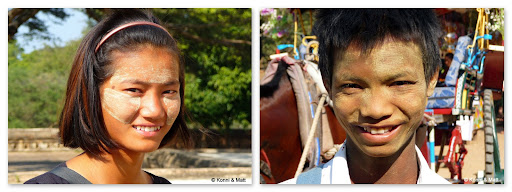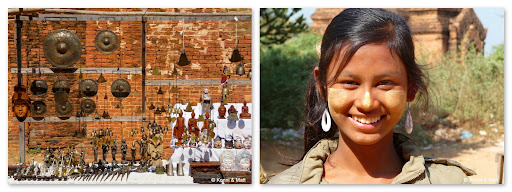Republic of the Union of Myanmar aka Burma
Nyaung U
Anawrahta Road
Oasis Guest House +956160923
Adequate a/c twin room with private bathroom for only MMK 10,000.- or US$ 12.- per night.
 Click below for an interactive road map of the Oasis Guest House in Nyaung U and for directions:
Click below for an interactive road map of the Oasis Guest House in Nyaung U and for directions:Exploring the touristy town of Nyaung U, the principal gateway for Bagan where the kings (and their forced labourers) built as many as 4,400 temples over a 230-year period on an arid riverside plain until it was overrun by the millions of Mongols of Kublai Khan in 1287 CE, with its gilded Shwezigon Paya, the prototype of virtually all later stupas over Myanmar, which is armed with an incredible number of donation boxes (“Buddhism isn’t merely a religion, it’s a philosophy…”, at least according to all those friendly, soft-selling Buddhist professionals who chant unflinchingly this tricky mantra from the East and from the West).
Strolling over the lively morning market of Nyaung U, chatting and bargaining with the sweet and overweight local market women and learning (i) that plumpness is being perceived as a sign of attractiveness (maybe, the husband pays for the good doctor when his chubby later suffers diabetes, heart problems or degenerative joint diseases) and (ii) that the yellow stuff on the belles’ faces is made from the ground bark of the thanakha tree and serves as wildly popular combination of sunscreen, perfume and sexy make-up.
Studying the delicious Bamar breakfast cuisine at our favourite teashop, one of many cheap no-name neighbourhood teashops in Nyaung U: (i) spicy tea-leaf salad (la-hpeq dhouq) for MMK 400.- or US$ -.50 per helping, (ii) thick rice-noodle salad (naung-gyi dhouq) for MMK 300.- or US$ 0.35 per helping and (iii) dry yellow-noodle salad (khaut-swe kyaw) for MMK 200.- or US$ 0.25 per helping, always spiced up with a local masala of turmeric, ginger, garlic, salt and onions, plus plenty of peanut oil and flavoured with ngapi, which is a salted paste concocted from dried and fermented shrimp or fish.
Watching a team of young men playing Burmese chinlone aka “cane ball” by forming a circle and keeping the 12-cm diameter rattan ball airborne by kicking it soccer-style from player to player.
Hiring Soe Naing’s no. 132 horse cart for a relaxed 1-hp morning tour (08:30 - 13:00, MMK 8,000.- or US$ 10.- for the two of us) and touring the North Plain of the 42-sq-km “Bagan Archaeological Zone” for an introductory into Bagan’s 3,000-some tall and awesome temples (mingling Hindu styles from India with local-brewed Buddhist images) which are the most wondrous sight in Myanmar; our favourite ruins: (i) Ananda Pahto, a terraced temple, with a corncob golden hti (the umbrella-like decorated pinnacle atop a stupa) towering 52 m high, and one of the largest, best-preserved and most revered of all Bagan temples, (ii) Gawdawpalin Pahto, one of the largest temples, 60 m high, and (iii) white-coloured Thatbyinnyu Pahto, Bagan’s highest temple with a gold-tipped sikhara (the Indian-style, corncob-like temple final), a proud 63 m up.
Hiring Soe Naing’s no. 132 horse cart for a relaxed 1-hp morning tour (08:30 - 13:00, MMK 8,000.- or US$ 10.- for the two of us) and touring the North Plain of the 42-sq-km “Bagan Archaeological Zone” for an introductory into Bagan’s 3,000-some tall and awesome temples (mingling Hindu styles from India with local-brewed Buddhist images) which are the most wondrous sight in Myanmar; our favourite ruins: (i) Ananda Pahto, a terraced temple, with a corncob golden hti (the umbrella-like decorated pinnacle atop a stupa) towering 52 m high, and one of the largest, best-preserved and most revered of all Bagan temples, (ii) Gawdawpalin Pahto, one of the largest temples, 60 m high, and (iii) white-coloured Thatbyinnyu Pahto, Bagan’s highest temple with a gold-tipped sikhara (the Indian-style, corncob-like temple final), a proud 63 m up.
Studying the Buddha’s stylised body language and noticing amongst the hundreds of Buddha images three distinctive body postures (standing, sitting and reclining) and five distinctive hand gestures: (i) abhaya (Buddha's Protection: both hands extended forward with palms out), (ii) bhumispara (Buddha's Persistence: right hand touches the ground), (iii) dana (Buddha's Teaching: one or both hands extended forward with palm up), (iv) dhyana (Buddha's Meditation: both hands rest palm-up on the Buddha’s lap) and (v) vitarka (Buddha's Doctrine: thumb and fore- or middle finger form a circle, like PADI’s OK gesture).
Hiking repeatedly the Central Plain (from Myinkaba in the west to Nyaung U in the east) of the 42-sq-km “Bagan Archaeological Zone” (in 1975 CE Bagan was shaken by a 6.5-magnitude earthquake; many of the temples were badly damaged, but major reconstruction started almost immediately) and recuperating afterwards with excellent Myanmar vegetarian food (MMK 500.- or US$ 0.60 per person, from any of the stalls and cheap local eateries: sour veggie soup, rice with five different vegetables, bottomless Chinese tea) and with ice-cold Dagon Lager Green Label draft (our favourite pub: Holiday Beer Station, MMK 500.- or US$ 0.60 per pint).
Hiring Soe Lwin’s no. 240 horse cart for another relaxed 1-hp morning tour (08:30 - 13:00, MMK 8,000.- or US$ 10.- for the two of us) and touring the South Plain (famous for its many 13th-century CE murals) of the 42-sq-km “Bagan Archaeological Zone” for a farewell trip of Bagan’s almost innumerable stupas aka zedis (solid, bell-shaped holy shrines), pahtos (hollow, square or rectangular shrines) and kyaungs (Buddhist monasteries); our favourite ruins: (i) Tayok Pye Paya, a spired temple with great views from its upper reaches, (ii) Nandamannya Pahto, a small mid-13th century CE temple with the “Temptation of Mara”, a mural with nubile young girls with remarkable boobs who attempt to distract the Buddha from the meditation session that led to his enlightenment, and (iii) Kyat Kan Kyaung, a working underground monastery dating from the 11th century CE (where apparently a Buddhist monk died during meditation in recent years and was left undisturbed for days; everyone thought he was still meditating…).
Climbing the steep Buledi Pagoda stairways to watch the sun dip behind the mountains in the west and the famous Bagan sunset turning all shades of tangerine, lavender and rust, afterwards sun-downing with genuine Scotch (Highland Pride, labelled: “Singapore - Duty not Paid”, for only MMK 2,500.- or only US$ 3.- per 0.7-ltr bottle from any of the rugged bottle stores near the market) and people-spotting two distinctive tribes of international tourists who looked as if they were coming from a fancy-dress ball: (i) older folks, mostly from the more republican homelands, clad in khaki expedition uniforms “out of Africa”, very expensive and fresh from the mail-order catalogue, and (ii) younger folks, mostly from the more democratic homelands, who tried “to blend in with the locals” by wearing pseudo-native, home-spun stuff (which no Burmese could afford or would ever put on), also very pricey and fresh from the local souvenir shops/boutiques for western tourists.
Taking the bone-shaking, crowded Nyaung-U-Mann bus from Nyaung U to Shwen Yaung (about 290 km, 10 ½ hours, MMK 10,500.- or US$ 12.80 per person) on a very dusty, pot-holed road with many roadworks, where beautiful young Burmese women slaved as manual labourers in the sun and where strong young Burmese men meditated as monks in the shade, and thereafter hiring a túk-túk (11 km, ½ hour, MMK 1,000.- or US$ 1.20 per person; plus, at a roadblock, the compulsory US$ 5.- entrance fee to the Inle Lake zone for foreigners) right to our hotel in Nyaung Shwe, the hyped-up, overrated tourist trap (with prices for street food unbudgingly two/three times higher than in the rest of Myanmar), situated about 3 km north of the Inle Lake and overrun with elderly Westerners (mostly monoglot Merdestanis).
Recommended books - click below for your Amazon order from the United Kingdom:

























































